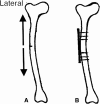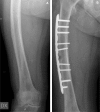Lateral fixation: an alternative surgical approach in the prevention of complete atypical femoral fractures
- PMID: 28924690
- PMCID: PMC5775348
- DOI: 10.1007/s00590-017-2041-6
Lateral fixation: an alternative surgical approach in the prevention of complete atypical femoral fractures
Abstract
Little evidence is available on how to treat incomplete atypical fractures of the femur. When surgery is chosen, intramedullary nailing is the most common invasive technique. However, this approach is adopted from the treatment of other types of ordinary femoral fracture and does not aim to prevent the impending complete fracture by interrupting the mechanism underlying the pathology. We suggest a different surgical approach that intends to counteract the underlying biomechanical conditions leading to a complete atypical fracture and thus could be better suited in selected cases. Here, we share an alternative surgical approach and present two cases treated accordingly.
Keywords: Atypical fracture; Bisphosphonate; Femoral fracture; Fracture prevention; Osteoporosis.
Conflict of interest statement
All authors declare that they have no conflict of interest.
Figures




Similar articles
-
Prophylactic nailing of incomplete atypical femoral fractures.ScientificWorldJournal. 2013;2013:450148. doi: 10.1155/2013/450148. Epub 2013 Jan 9. ScientificWorldJournal. 2013. PMID: 23365544 Free PMC article.
-
[Distal fractures of the femur].Chirurg. 2002 Dec;73(12):1221-33; quiz 1233-4. doi: 10.1007/s00104-002-0583-5. Chirurg. 2002. PMID: 12491053 Review. German. No abstract available.
-
Comparison of two biological internal fixation techniques in the treatment of adult femur shaft fractures (plate-screws and locked intramedullary nail).Ulus Travma Acil Cerrahi Derg. 2011 Mar;17(2):159-65. Ulus Travma Acil Cerrahi Derg. 2011. PMID: 21644095
-
Fractures of the adult femur excluding the femoral head and neck: a review and evaluation of current therapy.Clin Orthop Relat Res. 1980 Mar-Apr;(147):93-114. Clin Orthop Relat Res. 1980. PMID: 6989543 Review.
-
[Osteosynthesis for periprosthetic supracondylar fracture above a total knee arthroplasty using a locking compression plate].Acta Chir Orthop Traumatol Cech. 2009 Dec;76(6):473-8. Acta Chir Orthop Traumatol Cech. 2009. PMID: 20067694 Czech.
Cited by
-
Surveillance of atypical femoral fractures in a nationwide fracture register.Acta Orthop. 2022 Jan 11;93:229-233. doi: 10.2340/17453674.2022.1380. Acta Orthop. 2022. PMID: 35019144 Free PMC article.
-
Precontoured Plate Fixation for Incomplete Atypical Diaphyseal Fracture of Femur using Three-Dimensional Printing Rapid Prototyping: Two Cases Reports.Orthop Surg. 2021 Feb;13(1):353-359. doi: 10.1111/os.12867. Epub 2020 Dec 6. Orthop Surg. 2021. PMID: 33283486 Free PMC article.
-
A Periprosthetic Femoral Fracture with Characteristics of Atypical Femoral Fracture.Case Rep Orthop. 2019 Jul 16;2019:1275369. doi: 10.1155/2019/1275369. eCollection 2019. Case Rep Orthop. 2019. PMID: 31396425 Free PMC article.
-
Intramedullary Nailing: Definitive as well as Prophylactic Fixation Method in a Case of Bilateral Atypical Femoral Fractures - A Case Report.J Orthop Case Rep. 2019;9(3):61-64. doi: 10.13107/jocr.2250-0685.1422. J Orthop Case Rep. 2019. PMID: 31559230 Free PMC article.
-
Plate osteosynthesis for atypical femoral fractures in patients with severely bowed femurs: comparing short versus long segment fixation - a case series.Int J Burns Trauma. 2022 Jun 15;12(3):73-82. eCollection 2022. Int J Burns Trauma. 2022. PMID: 35891970 Free PMC article. Review.
References
-
- Harvey EJ. Bisphosphonates are not always helpful: commentary on an article by Hae-Seong Lim, MD, et al.: “factors associated with increased healing time in complete femoral fractures after long-term bisphosphonate therapy”. J Bone Joint Surg Am. 2016;23:e107. doi: 10.2106/JBJS.16.01009. - DOI - PubMed
MeSH terms
LinkOut - more resources
Full Text Sources
Other Literature Sources
Medical

